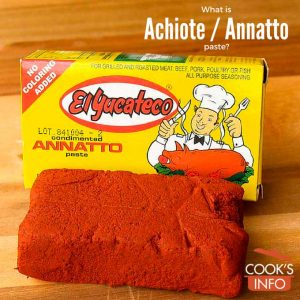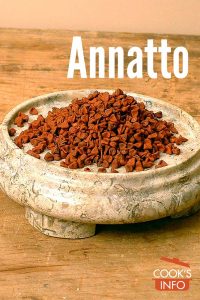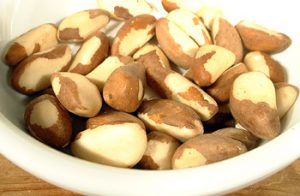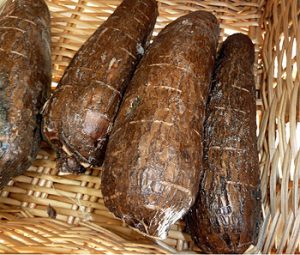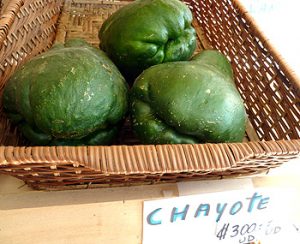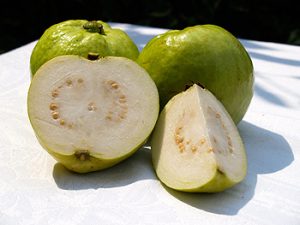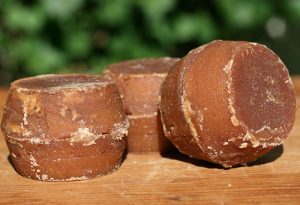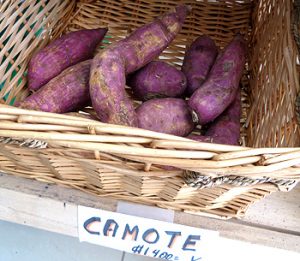Acerola is fruit from the Acerola tree. The fruits are very small, about the size of a cherry, anywhere from ½ inch to 1 inch (1 to 2 ½ cm) wide, with thin, glossy skin. They grow either by themselves or in clusters of two or three. The fruit ripens from yellow to orangish-yellow or…
Latin American Food
Achiote Oil
Achiote Oil is an oil that has been coloured with annatto seed (also known as achiote seed.) The annatto seed itself adds no flavour, just colouring. Flavour may sometimes by added as well, though, with a dried chile pepper or a bay leaf. Some Vietnamese batters are made with annatto oil to make the batter a…
Achiote Paste
Achiote Paste © Denzil Green Achiote (aka Annatto paste) is made from ground annatto seeds, which give it its colouring, and from other items which give it its flavour, such as cinnamon, salt, oregano, garlic, cloves, coriander, cumin, and bay leaves. The items used will depend on what brand you buy. Acetic acid is often…
Achiotina
Achiotina is lard that has been coloured with annatto (also known as achiote.) It is used mostly in Caribbean and Puerto Rican cooking for frying meats and vegetables, and for making stews, rice and bean dishes. Cooking Tips Gently fry a few annatto seeds in lard for about ten minutes or until the fat is…
Alphonso Olives
The Alphonso Olive tree cultivar was developed in Chile. It is also grown in Argentina and Peru. Chilean black Alphonso Olives tend to be cured in red wine vinegar, which deepens their purple colour. Alphonso Olives from Argentina and Peru tend to be cured in brine and packed in vinegar or brine. They have a…
Annatto
Annatto © Denzil Green Annatto is a seed used as a food colouring. In many people’s view, it has little or no discernible taste. Annatto comes from a bush, conveniently also called “Annatto”, which is native to South America. The bush flowers with blossoms that may be either bright white, or pink. Pink annatto bush…
Añú
Añú is a cold-hardy, perennial plant related to the nasturtium that people grow in their flower gardens. The plant can climb up about 7 feet (2 metres) tall or spread out along the ground. The flowers, yellow petals with red spurs, are smaller than those of garden nasturtiums. The plant is classed as an herb….
Arauco Olives
Arauco Olives are dark green olives grown in Spain and in Argentina. They are very large olives harvested green, cured in brine, and usually flavoured with herbs such as rosemary. The trees were brought to Latin America by the Spanish at the time of the conquest. They are now the main olives grown in Argentina….
Bolo de Milho: Brazilian Corn Cake
Bolo de Milho (“milho” meaning “corn”) is a corn cake popular in Brazil and in the Azores. It is similar to North American Johnnycake or cornbread, but sweeter. The batter is made with cornmeal, coconut milk, condensed milk, sugar, baking powder and egg. It is typically baked either in a flat, square cake pan, or…
Brazil Nuts
Brazil Nuts © Denzil Green Brazil Nut trees are grown in Peru and Bolivia as well as in Brazil. The trees grow up to 165 feet tall (50 metres.) Attempts at growing the trees in plantations have so far failed to produce Nuts. Only a certain type of bee, called Euglossine bees, can really pollinate…
Cassava
Cassava (aka Yuca) © Leclaire & Schenk The Cassava plant is a shrub that grows from about 3 to 10 feet above ground (1 to 3 metres), with huge tuberous roots about 3 feet long (1 metre) weighing up to 20 pounds (9 kg.) The roots have a rough, brown, tough exterior bark-like skin, with…
Cassava Flour
Cassava flour is a flour made from ground cassava roots. It is used for unleavened baking, or as a thickener. To make cassava flour, cassava roots are fermented or boiled, then dried and ground into a flour. No insects, not even cockroaches, will eat cassava flour. Substitutes When a recipe calls for cassava flour as…
Chayote
Chayote © Leclaire & Schenk Chayote are sold as “Chayote Squash”, though they are not really a squash — they’re gourds that are treated as Summer Squash in cooking. Chayote are very small squash, only about the size of a large pear, being only about 3 to 4 inches long (7.5 to 10 cm.) They…
Dulce de Leche
Dulce de Leche is a form of condensed milk made in Latin America It is called “Dulce de Leche” in Argentina, Uruguay and Mexico; “manjar blanco” (“blanc mange”) in Chile and in Panamá, and “arequipe” in Columbia and Venezuela. It is usually made from cow’s milk, and is a tan or a deeper brown colour….
Guava Fruit
Guava Fruit © Denzil Green The Guava tree is an evergreen tree (in the tropics, at least.) The tree starts to bear fruit within two years of planting. After 5 years, a tree can bear five to six hundred fruits a year. The tree will live up to 40 years, but it is not very…
Guava Paste
Guava Paste is a very thick, purée of Guava Fruit. It is stiff and dense, almost like a fruit leather, but still soft and easily cut with a knife. It is sold in small and large blocks, or canned, but not in jars. The small blocks are about six inches long, an inch wide, and…
Hallacas
Hallacas are a South American version of Mexican Tamales. The fillings are very similar, including being surrounded by dough made of Masa Harina, but they are wrapped in banana leaves instead of corn husks before cooking, which is usually done by boiling. Most recipes originate in Venezuela.
Malanga
Malanga is a starchy root vegetable that looks like a yam. The plant is a tropical rain forest plant, but it doesn’t need water all the time, and grows fine in full sunlight. The temperature, though, must remain above 68 F (20°C.) Above ground, the plant can grow 5 feet (1.5 metres) tall or more….
Oca
Oca is a root vegetable. Above ground, the plant (which is actually an herb) is a very small perennial, only growing about 8 to 12 inches high (20 to 30 cm.) Its stems can be yellow and green or purplish. It is propagated by replanting its tubers. The edible tubers that grow underground look like…
Panela
Panela © Denzil Green Panela is unrefined sugar with a high molasses content. Non-centrifugal means are used to produce the sugar. Sugar cane juice is just evaporated over heat until it forms a syrup called “miel” (sic), then it is boiled and stirred until it crystallizes and forms “panela.” Panela is sold in squat blocks….
Pasta de Axchiote
Pasta de Axchiote is a paste made from Annatto seeds that have been ground up. It gives a dark red colour to food, but no additional taste. You can use it as is in your cooking, stirring some of the powder into the liquid of what you are cooking, or rubbing it into the surface…
Rocoto Peppers
Rocoto Peppers grow on a plant with hairy leaves and stems. In the right climate, the plant is a perennial, with a life span of about 10 years. If not cut back (as it should be), it will grow up to 10 feet tall (3 metres.) The plant produces blue or purple flowers, and then…
Salmuera
Salmuera is Spanish for brine, or put even more simply salt water. You’ll see it called for sometimes in Latin American recipes, especially Argentine ones. Cooking Tips Because it’s just salt water, it’s very easy to make. Whisk 2 teaspoons of fine salt or 1 tablespoon of a coarser salt, such as Maldon, Kosher or…
White Sweet Potatoes
White Sweet Potatoes (aka Camote) © Leclaire & Schenk White Sweet Potatoes are a sweet potato that is very popular in the Caribbean and in Latin America — it’s what they think of when they hear “sweet potato.” The potatoes have rough, mottled skin that can be purplish or reddy with creamy-white flesh inside, and…


